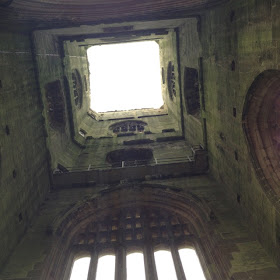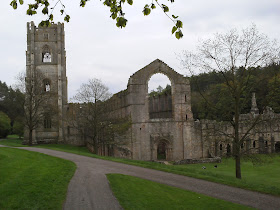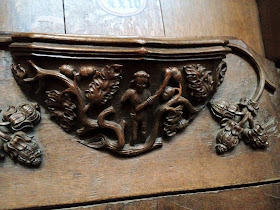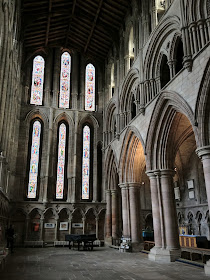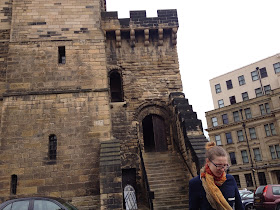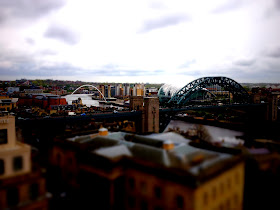Our
schedule allowed us only 1 hour in Newcastle then we were off to Durham. Durham
is another picturesque village the center of which is the university and the
cathedral. I must admit the juxtaposition of open mouthed wandering tourists
and nervous nail biting last seconds of revision before exam students was
confusing and amusing at the same time. I also have to admit that I feel
jealous for the stunning views the students get to enjoy and also that the top
floor of the Durham Castle was converted to a hall of residence.
As for the cathedral, it was the first Great English
Cathedral that we saw on the route and I was charmed by it its laid back, it’s
easy going, and neither the cathedral nor its people are trying to impose
themselves on the visitors.
 |
| Durham castle = hall of residence |
Despite looking mammoth on the photographs up close it looks
short and stubby; the exterior is by far less interesting than the interior and
is fairly plain compared to Lincoln, York, and Ely.

From Durham it was a bit of a stretch to Fountains Abbey and as it turns out the choice of radio stations is scarce in the middle of nowhere thus the background noise during the journey consisted of dubstep or white noise which were hard to tell apart anyway.
Fountains abbey was my dream since I learnt about the place in second year of university. For some reason the idea of it seemed very Lord of the Rings to me – a ruined abbey in the middle of the forest, the skeleton of what was once there, a decaying testimony to great achievements. And when I write great achievements I am not exaggerating. The Cistercian monks who lived in Fountains enjoyed indoor plumbing and heating over 500 years before the rest of the world. What was even more fascinating is that half of the abbey’s building where built on a river.


As we left Fountains it was clear that we will not make it to York before it closes. Thus we decided to go to Harrogate for the evening. We never made it there as I saw a church tower just as we were leaving Fountains abbey and being the navigator I navigated our way there. 'There' turned out to be Ripon Cathedral a jewel I have not heard of before. Ripon has been a site of worship for something like 1350 years. Interestingly it was also connected to Hexham abbey which we saw earlier that day through Saint Wilfred and to Durham through Venerable Bede. Indeed he was the one who founded a monastery on the site c. 660 and his remains found their last resting place in Durham.
Also to my greatest pleasure the 15th century misericords were open to the public and they were awesome.

A Siren (mermaid) carrying a hair brush and mirror - symbols of luxuria.
A Green man
And my favourite of all - the Wild man, you can just make out the hair covering the body and the huge club in his hands.
After trading Harrogate for Ripon it was time to make our way to York.

The story of Durham Cathedral starts hundreds of kilometers away on Lindisfarne Island the monastery there was home to Saint Cuthbert. At the end of the 9th century the monastery had to move because of the continuing Viking raids the remains of Saint Cuthbert were taken with them. At the end of the 10th century the monks moved again as the legend has it they followed two maids who were searching for their cow as they came into a peninsula formed by a loop in the River Wear Saint Cuthbert's coffin became immovable and that is where Durham was founded.
Taking photographs was not allowed but a managed to sneak one.
The columns of the Cathedral were fascinating - every second one was with a pattern, each pair had their own pattern. Yet there was one odd column in a transept whose pattern did not match its pair. I can not help to wander if this was dome intentionally or if somebody screwed up at one of the stages of its order or production.
From Durham it was a bit of a stretch to Fountains Abbey and as it turns out the choice of radio stations is scarce in the middle of nowhere thus the background noise during the journey consisted of dubstep or white noise which were hard to tell apart anyway.
Fountains abbey was my dream since I learnt about the place in second year of university. For some reason the idea of it seemed very Lord of the Rings to me – a ruined abbey in the middle of the forest, the skeleton of what was once there, a decaying testimony to great achievements. And when I write great achievements I am not exaggerating. The Cistercian monks who lived in Fountains enjoyed indoor plumbing and heating over 500 years before the rest of the world. What was even more fascinating is that half of the abbey’s building where built on a river.

 |
| Reconstuction of the Abbey. |

As we left Fountains it was clear that we will not make it to York before it closes. Thus we decided to go to Harrogate for the evening. We never made it there as I saw a church tower just as we were leaving Fountains abbey and being the navigator I navigated our way there. 'There' turned out to be Ripon Cathedral a jewel I have not heard of before. Ripon has been a site of worship for something like 1350 years. Interestingly it was also connected to Hexham abbey which we saw earlier that day through Saint Wilfred and to Durham through Venerable Bede. Indeed he was the one who founded a monastery on the site c. 660 and his remains found their last resting place in Durham.
Also to my greatest pleasure the 15th century misericords were open to the public and they were awesome.
I found grape vine carriers with a blemmye and another monstrous figure.

A Siren (mermaid) carrying a hair brush and mirror - symbols of luxuria.
A Green man
And my favourite of all - the Wild man, you can just make out the hair covering the body and the huge club in his hands.
After trading Harrogate for Ripon it was time to make our way to York.






